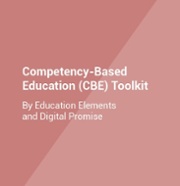When I’m on the road working with school districts across the country on everything from personalized learning to competency-based education (CBE), I often hear the same question: “Well how do other districts approach these issues?”
Thankfully, this year Education Elements partnered with Digital Promise, a national non-profit authorized by Congress, to document and share lessons learned on CBE from school districts across the country. We can now easily answer that question by sharing our new toolkit and saying - “this is what other districts did.”
The effort began a few years ago through the League of Innovative Schools, (Digital Promise’s national network of innovative K-12 school districts), when a working group was formed to discuss the different approaches districts take to move towards CBE. Last year, districts collaborated on a draft CBE “playbook” shared within the group. This year, with funding from the Gates Foundation, we were able to build upon previous efforts as 10 school districts from across the country shared videos, write-ups, and artifacts such as presentations and handbooks that document their work moving to CBE.
The work was not easy. One of the first things we had to do was clarify how different districts thought about implementing CBE. After reviewing last year’s “playbook” and talking to districts on monthly calls, we built a matrix to classify the different priorities districts must balance as they shift to CBE. You can find that CBE framework here.
At the November League of Innovative Schools meeting in Baltimore, over 20 districts collaborated in a workshop to think through different elements of the framework and document some of their efforts to shift to CBE.
From there, 10 districts then took on the charge of deeply reflecting on their work and sharing it with the education community at large. In their reflections you’ll find their rationale for moving to CBE, surprises and trade-off’s they’ve faced, considerations for other organizations, and artifacts that show you “what it looks like.” We are deeply indebted to these districts for the time, effort, and courage it took to share their work:
- Franklin West Supervisory Union (VT);
- Fulton County Schools (GA);
- Kettle Moraine School District (WI);
- Lindsay Unified School District (CA);
- Pascack Valley Regional High School District (NJ);
- Piedmont City School District (AL);
- Seminole County Public Schools (FL);
- Sitka School District (AK);
- Utah Schools for the Deaf and the Blind (UT); and
- Vista Unified School District (CA).
Now, we’re proud to share the CBE Toolkit with anyone looking to learn more about how districts are challenging some of the fundamental assumptions around how school systems are designed and implemented, and changing how students learn and progress through the K-12 system. You will learn how for some districts this is another step in their personalized learning journey while for others it is their starting point. You’ll find some districts taking big steps, like eliminating grade levels, and others just starting their CBE journey by defining learning objectives or making assessment schedules more flexible. You’ll also find resources pulled from national thought leaders in CBE, like CompetencyWorks and the Christensen Institute, both of whom were invaluable thought partners as we planned the shape and purpose of the toolkit this year.
Whatever your starting place, and wherever you’re coming from, we know you’ll find great resources to help think through some of the key issues districts face as they move to CBE. And we’d love to hear how you’re doing, so don’t hesitate to reach out to us at info@edelements.com or tweet @edelements using #cbetoolkit, and #DPLIS. Enjoy!
Get the Toolkit!





